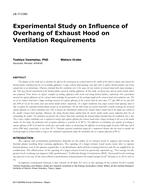Description
The purpose of this study was to elucidate the effect of the overhang of an exhaust hood on the ability of the hood to capture and contain thethermal plume resulting from the use of cooking appliances. Larger exhaust hood openings seem more able to capture thermal plumes even if theyexpand due to air disturbance. However, provided that the ventilation rate is the same, the face velocity of exhaust hoods with larger openings islow. This may prevent containment of the thermal plume caused by cooking appliances. In this study, an electric fryer and an electric noodle cookerwere prepared. These devices are typical examples of cooking appliances with weak and strong thermal plumes, respectively. Our experimentsrevealed the capture efficiencies of the exhaust hood, including the parameters of the overhang length of the exhaust hood and ventilation rate. Theuse of an exhaust hood with a longer overhang increases the capture efficiency of the exhaust hood by more than 177 cfm (300 m³/h) and 265cfm (450 m³/h) for the electric fryer and electric noodle cooker, respectively. At a higher ventilation rate, larger exhaust hood openings must beable to capture the expanded thermal plume because of air disturbance. On the other hand, an exhaust hood with a shorter overhang has increasedcapture efficiency at a lower ventilation rate. This is because the containment ability of the exhaust hood is higher due to the higher face velocity ofthe smaller exhaust hood openings. Moreover, the strong thermal plume emitted from the electric noodle cooker causes induction from the airsurrounding the cooker. The induction air prevents the exhaust hood from containing the thermal plume provided that the ventilation rate is low.This is why a higher ventilation rate is required to realize high capture efficiency for exhaust hoods with a longer overhang in the case of the noodlecooker. In this study, the permissive level of capture efficiency is assumed to be 90 %. The difference in ventilation rate capable of realizing acapture efficiency of 90 % for both the electric fryer and noodle cooker, as derived from the difference in overhang length (4 inches (100 mm) and 8inches (200 mm), respectively), is less than 10 %. Therefore, practical ventilation design for a commercial kitchen does not need to consider theoverhang length of exhaust hoods as long as the ventilation requirements define the ventilation rate at a capture efficiency of 90 %.
Citation: 2017 Annual Conference, Long Beach, CA, Conference Papers
Product Details
- Published:
- 2017
- Number of Pages:
- 8
- Units of Measure:
- Dual
- File Size:
- 1 file , 740 KB
- Product Code(s):
- D-LB-17-C065




